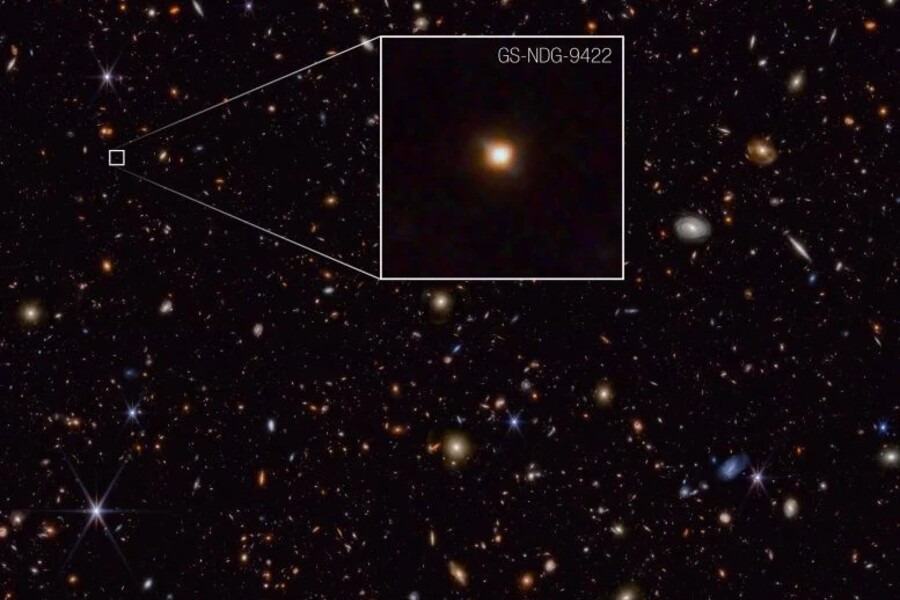NASA’s James Webb Space Telescope has once again redefined our understanding of the cosmos, uncovering a galaxy with a truly extraordinary characteristic. Known as GS-NDG-9422, or simply 9422, this galaxy, found about one billion years after the Big Bang, emits a unique light signature that has left scientists both puzzled and excited. What sets it apart is its nebular gas outshining its stars—a phenomenon that may represent a critical transitional phase in galactic evolution. This discovery could provide crucial insights into the mysterious bridge between the universe’s first stars and the structured galaxies we observe today.
Alex Cameron, a lead researcher at the University of Oxford, described his reaction upon reviewing the galaxy’s spectrum data captured by Webb. “My first thought in looking at the galaxy’s spectrum was, ‘That’s weird.’ And that’s exactly what Webb is built to uncover—phenomena we’ve never seen before that challenge our understanding of the early universe,” Cameron explained. This unexpected light signature quickly became the focus of collaborative research with theorist Harley Katz, also from Oxford and the University of Chicago.
Together, Cameron and Katz delved into the data, analyzing the unusual light emission patterns using advanced computational models. They found that the galaxy’s spectrum closely matched predictions of nebular gas heated to extreme temperatures by incredibly bright, massive stars. These stars, according to Katz, are significantly hotter and more massive than anything seen in the local universe today. “It looks like these stars must be much hotter and more massive than those we see in our galaxy,” Katz remarked, adding that this makes sense given the vastly different environmental conditions of the early cosmos.
The stars in 9422 exceed temperatures of 140,000 degrees Fahrenheit (80,000 degrees Celsius), compared to the 70,000–90,000 degrees Fahrenheit (40,000–50,000 degrees Celsius) typical of hot stars in today’s galaxies. This intense heat is thought to result from a brief, dynamic phase of star formation, where dense gas clouds produce an exceptional number of massive stars in rapid succession. The immense number of photons emitted by these stars overwhelms the surrounding gas, causing it to glow brightly—so brightly that it appears more luminous than the stars themselves.
This peculiar light signature is particularly intriguing because it aligns with predictions for the environments of the universe’s earliest stars, known as Population III stars. These primordial stars were theorized to form in the absence of heavy elements, making them vastly different from stars in later epochs. However, while 9422 is not home to Population III stars (its chemical complexity rules out that possibility), it provides tantalizing clues about the transitional phases between these first-generation stars and the more chemically enriched stars found in today’s galaxies.
“The stars in this galaxy are not like Population III stars, but they’re also not like the ones we’re familiar with,” Katz explained. “They could serve as a guide to understanding how galaxies transitioned from primordial stars to the types we know today.” This discovery opens the door to further exploration of these intermediate phases in cosmic evolution, a topic that has long eluded astronomers.
Despite the excitement surrounding 9422, many questions remain unanswered. Is this phenomenon unique to 9422, or could it be more common in galaxies from this period? What can these findings reveal about even earlier stages of galactic development? To answer these questions, Cameron, Katz, and their team are working to identify more galaxies with similar characteristics. By building a larger dataset, they hope to unravel the conditions of the universe’s first billion years—a critical window in cosmic history.
The team’s findings, published in the Monthly Notices of the Royal Astronomical Society, represent only the beginning of what promises to be a transformative era in astronomy. The James Webb Space Telescope, with its unparalleled ability to peer into the early universe, is revolutionizing our understanding of cosmic evolution.
“This is a truly exciting time for astronomy,” Cameron said. “The Webb telescope has given us access to an epoch of the universe that was previously beyond our reach. With each discovery, we are rewriting the story of how the cosmos began.”
As researchers continue to explore the mysteries of galaxies like 9422, it’s clear that the Webb telescope is not only reshaping our understanding of the universe’s past but also paving the way for countless future discoveries. Humanity is on the brink of uncovering secrets that have been hidden since the dawn of time—a thrilling reminder of how far we’ve come in our quest to understand the cosmos.
